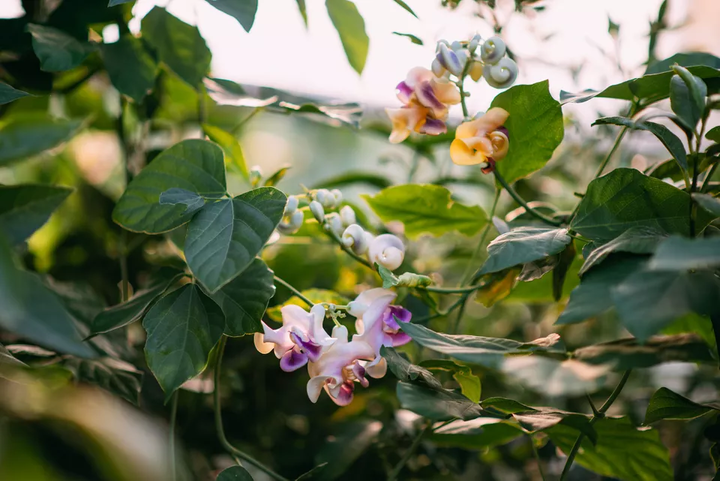The corkscrew vine, corkscrew flower, or snail flower (vigna caracalla) is a rapid-growing, twining, perennial vine with fragrant flowers. This member of the pea family is native to the tropical areas of Central and South America, and it thrives in regions that replicate these types of conditions.

The corkscrew vine has also naturalized--and sometimes aggressively self-seeds and spreads--in parts of California.
It's an evergreen, deciduous plant when grown in frost-free regions, and known for its ornamental attractiveness. Its showy flowers twist spirally on the vine, so it looks like a corkscrew. The flower gets its "snail" moniker thanks to the fact that the way its flowers curl closely around resembles a mollusc shell.
From July to October, and up until the first frost, the corkscrew vine blooms highly fragrant white and lilac/purple flowers, and they are sometimes marked with yellow and cream colors. Its spiraling flowers are about two inches long and grow in erect clusters, known as racemes, that can reach up to a foot long. Its vines sprout green leaves, which each have three leaflets about three to five inches long.
The flowers are accompanied by dangling, narrow bean-like pods that are six to seven inches long and one-inch wide, and contain round brown seeds.
Botanical Name:
Vigna caracalla
Common Name:
Corkscrew vine
Plant Type:
Vine
Mature Size:
12-30 feet
Sun Exposure:
Full sun
Soil Type:
Moist, well-drained
Soil pH
:6-8
Bloom Time:
Late summer/Fall
Flower Color:
White, purple
Hardiness Zones:
9-12
Native Area:
Central and South America
Corkscrew Vine Plant Care
The fast-growing corkscrew vine is relatively easy to grow from seed, however, its vine-like structure means it will need a support structure on which to grow. They may be grown as either a perennial or an annual, and as a cover for a fence, arbor, wall, or trellis.
Just be aware that once it's established, the corkscrew vine is a very fast grower and may very well take over your entire garden, and even the rest of your backyard, so be sure to closely monitor its growth and spread.
These plants are not associated with any significant insect or disease problems and are known to attract both birds and butterflies. The corkscrew vine's flowers are primarily pollinated by ants.
Light
Corkscrew vine plants will grow best when planted in full sunlight. They can also tolerate partial shade.
Soil
When growing corkscrew vine plants, the soil should be fertile, moist, and well-drained.
Water
You'll want to make sure the corkscrew vine's soil never becomes overly soggy. Water the vines only when they appear dry, and keep the water at soil level. You should also allow the excess moisture to seep away after watering. Applying a three-inch layer of mulch can help maintain soil moisture.
Temperature and Humidity
These plants love heat and humidity, and will always grow best in tropical climates. They can be grown in northern climates but will have to be moved indoors well before the first frost of the winter. corkscrew vines will not do well once temperatures dip below 50 degrees Fahrenheit.
Fertilizer
Though the corkscrew vine doesn't necessarily require fertilizer, you can use an organically-sourced and balanced granular fertilizer to promote its growth.
Propagating Corkscrew Vine
The corkscrew vine plant can be propagated by seed and is usually started indoors, as it handles transplanting well. Try using toenail clippers to clip the seed coat about at least halfway around the edge of the seed to encourage successful germination.
Be sure to sow the seeds with only a light covering of soil on top. They will take up to six days to germinate depending on the temperature of the soil and whether or not the seed coat is scarified.
Pruning
In addition to monitoring its spread to prevent it from taking over your garden, once your corkscrew vine has matured, you'll want to cut back its leaves and tendrils. This will help promote more significant flowering.
Growing in Containers
The corkscrew vine can be grown in containers and then brought indoors in northern climates and other regions where the plant is not winter hardy. Just be sure there is excellent drainage within the pots and that you place it in front of a sunny window.